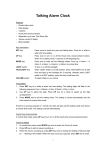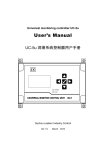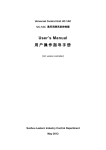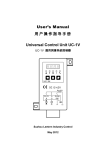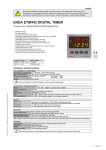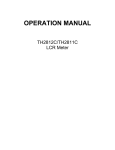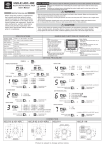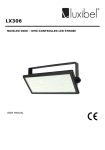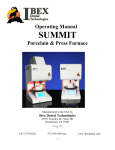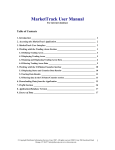Download UC-5M user manual -E
Transcript
Universal monitoring controller UC-5m User’s Manual Single-line lubrication control Dual-line lubrication control Suzhou Leetern Industry Control Ver 1.0 Oct. 2011 Contents 1.Display and control panel 1.1 LED pilot lights 1.2 Keys 1.3 LCD display 2.Main lubrication function 2.1 Auto lubrication 2.1.1 Timer lubrication 2.1.2 Counter lubrication 2.1.3 Combined control mode 2.2 Insert lubrication 2.3 External control interlock 2.4 Fault monitoring 2.6 Information storage 3. Menu mode 3.1 Enter menu mode 3.2 Lubrication 3.3 View information 3.3.1 View system information 3.3.2 View parameters 3.3.3 View monitoring information 3.4 Setting 3.4.1 Enter setting menu 3.4.2 System setting 3.4.3 Parameters setting 3.4.4 Monitoring setting 4. Faults 4.1 Oil/grease level monitoring and gives alarm 4.2 Compressed Air pressure monitoring and alarm 4.3 Oil/grease pressure monitoring and alarm 4.4 Cycle Switch signal monitoring and alarm 4.5 Fault message display and handle 5. Installation and electrical connection 5.1 Installation 5.2 Power supply 5.3 Electrical connection 6. Technical specification Universal Monitoring Controller UC-5 is designed for controlling and monitoring of both single line and dual line Lubrication systems. It is applicable to lubrication systems for all kinds of machinery equipment. The controller UC-5 intuitively displays operating information like operating state and parameters with LCD. It is easy to use. UC-5 stores configuration data and parameters in EEPROM, which made those data can be stored safely for long time. UC-5 is of completely sealed design, Its protection grade reaches IP65, thus it can work steadily in severe Industrial working environment. Safety Warning! Mounting and connecting controller UC-5 must be done under power cut-off condition. Hot-line work is prohibited to prevent electric shock hazard. Ground terminal of UC-5 must be well grounded. The system should be protected with specified fuse to ensure controller safe and personal security. UC-5 must be mounted, tested and maintained only by trained qualified personnel. In order to guarantee system operating safely and properly, its safe condition should be periodically inspected. Although UC-5 complies with relevant safety technical requirements, the use of the controller may still entail dangers leading to personal injury of the user or third parties or damage to property. Therefore, the operation must strictly comply with operation manual. Errors that may affect safety must be rectified immediately. UC-5 is designed for controlling and monitoring centralized lubrication systems. The user himself shall be liable for any damage caused by improper use. 1. Display and control panel Display and control panel of UC-5 1.1 LED pilot lights POWER – power pilot light. When power supply to the controller is normal, the green pilot light of POWER is on. INFO – Information pilot light. When controller detects fault, the red pilot light will be continuously flashing. 1.2 Keys -Key UP. Scroll up key. When selecting menu, press key UP to scroll up the menu; under setting mode, to increase the displayed value at cursor position with this key. -Key DOWN. Scroll down key. When selecting menu, press key down to scroll down the menu; under setting mode, to decrease the displayed value at cursor position with key DOWN. -Key LEFT. Scroll left key. To move cursor left in setting mode. -Key RIGHT: scroll right key. To move cursor right in setting mode. -Key OK: To start setting mode with key OK in display mode; Confirm menu or programmed parameters; this key also has function to exit fault state or advance terminate OIL DRAINING. 1.3 LCD monitor LCD displays operating status and parameters of the lubrication system. When controller is operating, LCD mainly displays current states. PAUSE means lubrication system is now in PAUSE state. Displayed content may be: LUBRICATION, PAUSE and STOP etc. TIMER means PAUSE control mode is TIMER mode. Displayed content may be TIMER (timer mode) and COUNTER (counter mode). “0024h 00min 00s” shows the preset PAUSE time. (Preset PAUSE time is 24 hours.) “0016h 30min 00s” shows the remaining PAUSE time at present . (There is still 16 hours 30 minutes left for PAUSE state.) In LUBRICATION phase, the two values represent preset value and remaining value for LUBRICATION. Under external control or inserted lubrication states, when system detects faults, LCD will display other messages. Please refer the detail information in follow chapters. 2. Main lubrication functions Controller supports multi lubrication control modes to meet actual lubrication project needs. Lubrication control modes include Auto lubrication mode, insert lubrication mode, external control interlock mode. During controller operation time, it can monitor external fault signal. Once controller detects any fault, it will gives alarm signal and get into stop state. 2.1 Auto lubrication Under normal operating conditions, if the controller is set as AUTO lubrication mode, the controller controls lubrication system working in continuous cycle of “PAUSE-LUBE-PAUSE…..” Auto lubrication control mode have two modes, TIMER control mode and COUNTER control mode. 2.1.1 Timer Lubrication TIMER lubrication control is the basic lubrication control mode. In this way, controller is set as TIMER mode for both LUBRICATION and PAUSE, and controller will automatically carries out the lubrication task in continuous cycle of “Timer mode of PAUSE-Timer mode of LUBE-Timer mode of PAUSE….. In TIMER control mode, the 2nd line of the message displayed on LCD monitor is TIMER. This means it is operating in TIMER mode. If the lubrication system is now in LUBRICATION state, the 1st line of the message displayed on LCD monitor is LUBRICATING. If system is right in PAUSE state, the 1st line is PAUSE, and the 3rd line and 4th line will show the corresponding preset parameter and remaining value. In TIMER control mode, PAUSE time and LUBRICATION time can be set separately. And programmable PAUSE time range is 0min to 9999h 59min, programmable LUBRICATION time range is 1s to 99h 59min 59s. In TIMER control mode, PAUSE time can be set as “0”, In this case, lube system operates in LUBRICATION state all the time and will not go to PAUSE state any more. 2.1.2 Counter lubrication LUBRICATION control can be set as COUNTER mode according to lubrication requirement. This is very useful for those single-line systems that need to be lubricated according to distributors’ movement times, or dual-line lubrication system that needs to be lubricated according to movement times of pressure difference switch at the end of the lines. In COUNTER control mode, controller will automatically carries out the lubrication task in continuous cycle of “TIMER mode of PAUSE - COUNTER mode of LUBRICATION – TIMER mode of PAUSE…. When preset PAUSE time ends, system goes into LUBRICATION state. In lubrication state, controller receives external COUNTER signal, when it receives the preset COUNTER signal numbers, lubrication state ends and system goes back to PAUSE state again. In COUNTER control mode, the 2nd line of the message displayed on LCD monitor is COUNTER, which means lubrication system is now in COUNTER control mode. Counter signals (counting semaphore) must be input controller via CS-1 terminal. Although CS-1 is served as counter signal input terminal, this does not affect its CS (Cycle Switch) monitoring signal input function. It is recommended to initiate CS monitoring function, to enable controller to monitor if the system operates within the specific lubrication time. 2.1.3 Combined control mode In special cases, PAUSE can be set as COUNTER control mode; LUBRICATION can be set as TIMER mode or COUNTER mode. In this control mode, controller can control large gear or chain’s lubrication. 2.2 Insert a lubrication Under normal situation, controller controls lubrication system working in continuous cycle of “PAUSE-LUBE-PAUSE…..”. When user need to do lubrication system’s testing and maintenance, or wants to lubricate the system occasionally, INSERT A LUBRICATION function will help. It is easy to insert lubrication in MENU mode. After initiate a lubrication, controller will stop current PAUSE or LUBRCATION task and perform the inserted lubrication. When the preset lubrication value ends, system will go to PAUSE state. During the inserted lubrication period, displayed information on LCD is “LUBRICATING﹒”. The mark ”﹒” follows LUBRICATING remind user it is a INSERTED lubrication. The inserted lubrication operation can be early ended by briefly press key OK . When inserted lubrication finishes or being manually ended, system automatically returns back to PAUSE state. 2.3 External control Some lubrication system needs to be interlocked control with host machine of the lubricated equipment. In this case, user may initiate the EXTERNAL CONTROL function. Once EXTERNAL CONTROL is initiated, controller can accept external interlock signal’s control. When external interlock switch closes, controller performs normal control. When external interlock switch opens, controller pauses its control and the information displayed on LCD is: When external interlock switch closes again, controller will then continue its control tasks from the interrupted point. During PAUSE state under external control mode, controller’s operation will be frozen. In this case, controller does not perform any lubrication control and fault monitoring task. 2.4 Fault monitoring Controller has perfect fault monitoring function that can monitor lubrication system’s operation situation. Once it detects fault, the controller will stop the system and then gives alarm. Controller has the following monitoring functions: Lubrication oil level monitoring Compressed air pressure monitoring Lubrication oil pressure build-up situation monitoring Cycle Switch monitoring. There are 3 CS monitoring levels. CS monitoring can be set as OFF, ALARM BUT NOT STOP and ALARM AND STOP. System power down monitoring For detailed information, please refer to relevant Fault monitoring chapters. 2.5 Information storage Controller can store preset working parameters permanently. Those parameters will not lose because of power down. Once SYSTEM POWER DOWN MEMORY function is initiated, controller will automatically store those operational states and remaining parameters at the point of power down when power down occurs. And controller continues carry out operation from the interrupted state when power re-supplied again. Please note: Due to the situation that the power supply to controller is different from that to lubrication system, user should use power down memory function cautiously. Because this may cause lubrication system and control system out of synchronous. 3. Menu mode In menu mode, user can set every function and control parameters, to review those preset parameters and information, to insert a lubrication etc. 3.1 Enter into MENU MODE Press and hold key OK for more than 3 seconds to enter into setting mode. Use key DOWN and UP to select item to operate/set. Press key OK to confirm the current selected item and go to next step. Please note: In MENU mode, if there is no KEY operations for more than 2 minutes, controller will automatically goes back to display mode. 3.2 Lubrication (Insert lubrication) Once the item LUBRICATION in menu is selected, controller will quit MENU mode then goes to LUBRICATION phase (this is INSERTED LUBRICATION). Starting value of inserted LUBRICATION is the preset time value of LUBRICATION. It reduces progressively until lubrication ends and goes to PAUSE state again. The inserted lubrication operation can be early ended by briefly press key OK. When system has any faults, insert lubrication operation can not be started. Troubleshooting must be done first Please note: Controller does not carry out oil pressure monitoring function during the inserted lubrication phase even oil pressure monitoring function initiated. 3.3 View information Enter into VIEW INFORMATION menu to review every function and settings of the lubrication system. But user cannot change those settings under this mode. This can avoid those settings being modified accidentally. 3.3.1 View system information VIEW SYSTEM INFO. can view system information and those function items that do not belong to lubrication control function. Select VIEW SYSTEM INFO item to enter into view system information menu. LCD monitor first display controller’s serial number and P.D. MEMORY (Power Down MEMORY) setting. Press key DOWN, LCD monitor displays EXTERNAL CONTROL setting and “----END----”, END means VIEW SYSTEM INFO. menu ends. Press key OK to quit MENU MODE and gets back to operational state display mode. Or press key UP to return last screen. 3.3.2 VIEW PARAMETER Select VIEW PARAMETER to view preset LUBRICATION and PAUSE control modes and control parameters. Select VIEW PARAMETER item to enter into view parameter menu. LCD monitor begins to show PAUSE control mode and control parameter. Press key DOWN, LCD monitor displays LUBRICATION control mode and control parameter. Press key DOWN, LCD monitor displays END, which means VIEW PARAMETER menu comes to the end. At this time, press key OK to quit MENU MODE and gets back to operational state display mode. Or press key UP to return last screen. 3.3.3 VIEW MONITOR (review monitoring function settings) Select VIEW MONITOR to view monitoring function setting situation. LCD monitor begins to show CS (Cycle Switch) monitoring setting situation. If the monitoring function of one Cycle Switch is closed, LCD shows OFF. (For example: CS2 monitoring function is OFF. ) If monitoring function of one Cycle Switch is initiated, then the corresponding CS monitoring setting will be the preset monitoring time value. Once CS monitoring is initiated, there will be a letter postfix “-A” or “-T” follows the CS monitoring time value to show monitoring level. The postfix “-A” means CS monitoring level is ALARM BUT NOT STOP. When controller detects CS error, controller will give alarm signal, but it will not stop the lubrication system; Postfix “-T” means CS control level is STOP. When controller detects CS error, it will give alarm and get the lubrication system stop to wait for user to handle faults. Press key DOWN, LCD displays the setting situation of CS3 and CS4. Press key DOWN, to see monitoring setting situation of other Cycle Switches. When all Cycle Switches are displayed, press key DOWN to display OIL LEVEL and CA (Compressed Air pressure) monitoring function settings. Press key DOWN, LCD displays OIL PRESSURE monitoring setting and “----END----“, this means VIEW SYSTEM INFO. menu comes to the end. Press key OK to quit MENU MODE and gets back to operational state display mode. Or press key UP to return last screen. 3.4 Setting With function SETTING can set all function and parameters of the lubrication system. To prevent functions and parameters will be modified accidentally, the setting menu is protected with a 4-digit password. 3.4.1 Enter into SETTING mode In MENU mode, select item SETTING, then press key OK. Controller will then ask for password. Please input 4-digit password. If the password is correct, user can go to next step. If user continue input wrong password 3 times, controller automatically exits MENU mode and goes back to display mode. The initial password is“0000” After enter the setting mode, all functions and control parameters of UC-5 can be modified. 3.4.2 SET SYSTEM ( System setting) Select SET SYSTEM and press key OK to enter system setting menu. This menu is mainly used to set those items that relate to system management. Select PASSWORD item, press key OK, the least significant digit of password then start blinking (the blinking position is called cursor position). User can modify password at this time. Use key DOWN and UP to change the value at cursor position. Use key LEFT and RIGHT to move the cursor position. Press key OK to confirm the new password. Password setting range is 0000~9999. Press key DOWN, then select item P.D. MEMORY (Power Down memory) and press key OK. At this time, the next line on the screen begins to blink. Use key DOWN and UP to change the setting. OFF: to shut down the power down memory function. ON: to initiate power down memory function. Press key OK to confirm the new P.D. MEMORY setting. Press key DOWN, LCD then displays EXTERNAL CONTROL setting and “----END----“(EXIT SETTING). Select EXTERNAL CONTROL, then press key OK, the next line begins to blink at this time. User may change the setting with key DOWN and UP. OFF: to shut down external control function. ON: to initiate external control function. Press key OK to confirm the new setting. If user select “----END----“(EXIT SETTING) and press key OK at this time, controller will quit MENU mode and gets back operational state display mode. If press key UP at this time, then goes back to last function. 3.4.3 SET PARAMETERS (Parameter setting) SET PARAMETER menu is used for LUBRICATION and PAUSE control mode and control parameters setting. Select SET PARAMETER and press key OK, LCD displays: then select PAUSE MODE and press key OK, the setting of PAUSE MODE begin to blink, which means this setting can be changed. Use key DOWN and UP to select specific control mode. There are two control modes TIMER and COUNTER for user to choose from. Press key OK to confirm the new control mode. Press key DOWN, select PAUSE VALUE and press key OK, the cursor position digit of the preset PAUSE VALUE begins to blink, user can change the PAUSE VALUE. Use key DOWN and UP can change the digit at cursor position. Use key LEFT and RIGHT can move cursor position. Please note: controller does real-time checking on the parameters change situation. Once the new value input is beyond the programmable range, controller then refuses the change. PAUSE value programmable range is 0-9999h 59min. If PAUSE is set as COUNTER mode, then the programmable range is 0-9999 9999. Press key OK to confirm the new PAUSE VALUE setting. With the same operation steps can change LUBRICATION MODE and LUBE VALUE settings. Please note: LUBRICATION VALUE cannot be set as 0 (zero). If LUBRICATION MODE is set as TIMER, then the programmable LUBE VALUE range is 1s – 99h 59min 59s. If LUBE MODE is set as COUNTER, the programmable LUBE VALUE range is 1-999 999 impulses. Press key DOWN, LCD displays END, which means parameter setting menu comes to the end. At this time, if user select END and press key OK, controller will quit MENU mode and gets back operational state display mode. If press key UP at this time, then user can select last programmed item. 3.4.4 SET MONITOR (Monitoring function setting) SET MONITOR menu is used to set monitoring functions. Select SET MONITOR and press key OK, LCD then displays If monitoring function of one CS is shut down, the corresponding setting is OFF. If monitoring function of a CS is initiated, then the displayed setting is preset monitoring time value and monitoring level. Use key DOWN to select a CS and press key OK. If monitoring function of the selected CS is already initiated, the least significant digit of the monitoring time value on the next line begin to blink, user can edit the parameter. If the monitoring function of the selected CS is shut down, then the monitoring time value is showed as all digit “0” and the digit at cursor position begin to blink. Use key DOWN and UP can change the digit at cursor position. Use key LEFT and RIGHT can move cursor position. Programmable monitoring time range of CS is 0-17h 59min 59s. If the value is set as 0, which means the monitoring function of this CS is shut down. If CS monitoring time value is not set as 0 (zero), which means CS monitoring function is initiated. Press key OK to get into CS monitoring level setting. Postfix parameters (postfix may be “-A” (give alarm but not stop system) or “-T” (alarm and stop the system)) that represents monitoring level is flashing and user can use key UP or DOWN to change CS monitoring level now. For example, CS1 monitoring level is changed to “-T”, this means once CS1 has faults, the system will stop. After user select the proper CS monitoring level, press key OK and the postfix of the monitoring level stop flashing. And the setting is stored until next change via setting. If system is stop due to CS error, to turn off CS monitoring function or lower monitoring level (change “-T” to “-A”), controller will control and adjust the system accordingly. Press key DOWN or UP can view and set all Cycle Switches’ monitoring function. Press key DOWN until LCD displays User then can set oil level monitoring and Compressed Air pressure monitoring functions. Factory setting for LOW OIL LEVEL monitoring is ON. Use key DOWN and UP to select LOW OIL LEVEL, then press key OK to get into setting menu. At this time, the preset content of the function is blinking, use key DOWN or UP to change the setting. The setting can be ON or OFF. Press key OK to confirm the new oil level monitoring function. Please note: we DO NOT suggest shutting down oil level monitoring function unless for temporary test need. If set LOW OIL LEVEL as OFF means to shut down the oil level monitoring function, this will make the lubrication system in a state of insecurity. Select CA MONITORING, the press key OK to change compressed air pressure monitoring setting. At this time, the preset content of the function is blinking, use key DOWN or UP to change the setting. The setting can be ON or OFF. Press key OK to confirm the new CA MONITORING setting. Press key DOWN, LCD displays OIL PRESSURE setting. Select OIL PRESSURE and press key OK to change the oil pressure monitoring setting. At this time, the preset content of the function is blinking, use key DOWN or UP to change the setting. The setting can be ON or OFF. Press key OK to confirm the new OIL PRESSURE setting. Press key DONW. At this time, if user select “----END----“(EXIT SETTING) and press key OK, controller will quit MENU mode and gets back operational state display mode. If press key UP at this time, then user can select last programmed item. 4. Faults Controller has ability to monitor the lubrication system and detect faults, gives alarm signals, which protect the system operate safe and reliable. 4.1 Oil level monitoring and alarm signal Controller can detect oil level situation via oil level switch. When it detects the oil level is low, it gives alarm signal and get the system into stop state. And, fault information displayed on LCD will be: Oil level switch must be Normally Closed switch. Please refer to chapter 5, <installation and electrical connection> for the connection. Factory setting of oil level monitoring is ON. If it is necessary, user may shut down this function in setting menu. 4.2 Compressed Air pressure monitoring and alarm signal Some lubrication systems use compressed air as the driving force. In this case, compressed air pressure need to be monitored to ensure lubrication system operates properly. Use Normally Closed pressure switch to detect the CA pressure. The pressure switch opens once pressure is too low. When controller detects the pressure switch is open, it gives alarm signal and gets the system into stop state. The Compressed Air pressure fault information displayed on LCD will be: Factory setting of CA PRESSURE monitoring is ON. If it is necessary, user may shut down this function in setting menu. 4.3 Oil pressure monitoring and alarm signal If the pressure built-up situation during lubrication period needs to be monitored, user may set OIL PRESSURE monitoring setting as ON (to initiate oil pressure monitoring function) Once this function is initiated, controller will monitor the oil pressure switch condition during lubrication period. If the pressure is not in closed condition when the lubrication period finish, controller will give alarm signal and get the system into stop state. Please note: If the lubrication is INSERTED lubrication, then the oil pressure monitoring function will not be carried out during lubrication period. Factory setting of OIL PRESSURE monitoring is OFF. If it is necessary, user may initiate this function in setting menu. 4.4 Cycle Switch signal monitoring and alarm signal For systems that use distributors to distribute oil/grease, or dual-line lubrication system that uses end pressure difference switch to control lubrication process, user need to use CS (Cycle Switch) monitoring function to monitor the functioning of the system. Controller UC-5 can monitor 8 CS at the same time (max.). Each CS can be individually initiated or shut down. The CS monitoring time and monitoring level for those initiated CS can be set individually. The role of monitoring time is: Each CS (Cycle Switch) corresponding matches an internal timer Tc. When lubrication starts, Tc begins to countdown. If CS signal is received during the countdown, Tc clears and re-start countdown. If no CS signal received until the Tc countdown to the preset monitoring time, this means CS error occur. If CS monitoring level is set as “-A”, controller will give alarm signal to remind user the CS fault and carry on lubrication task. If CS monitoring level is set as “-T”, controller will give alarm signal and get the system into stop state at the same time. 4.5 Fault display and handle When controller detects fault, LCD monitor will display corresponding fault information in text, meanwhile, FAULT pilot light (INFO)on control panel flashes. Fault output relay’s contact open to transfer the fault signal to control room or to connect other control system. Inside controller, there is fault alarm drive to directly drive 220V alarm device like warning light, alarm bell and so on. If power down memory function is enabled, the fault information that caught by controller will be stored in EEPROM. It will not disappear (even power-off) until user clears the fault manually. If the fault is just a warning of general nature (example: one CS monitoring occur warning fault), the information displayed on LCD will be switching between FAULT INFO. screen and normal operational screen, and switching time is 1 second. If the fault is a serious fault that causes system stop, LCD will display the fault info. only. When WARNING INFO. and STOP INFO. exist at the same time, controller will alternately display the two types of information. As show in the figures above, in the left figure, the first line displays ”STOP”, which means the lubrication system stop already. Controller also points out that the stop caused by S2 (Cycle Switch 2) failure. In the right figure, the first line displays “NO SIGNAL”, which means this is warning information. Controller also points out the cause of the failure is CS1. During the period that controller is switching between two screens, press and hold key UP, controller will pause to switch the screens and the screen displayed (at the time when user press key UP) will stay. This helps user to get clear information. When release key UP, controller will continue switching screen. If more than one CS occur warning faults or stop faults, controller will show all the failure CS information on the screen. After handling the fault, briefly press key “OK” to quit Fault State and clear fault information on LCD. Controller then goes back to normal lubrication cycle. But if the reason that causes the fault still exists, the above operation does not work. 5. Installation and electrical connection 5.1 Installation Installation dimensions of the controller are show as figure above. The control panel of the controller should be perpendicular to the earth, and controller to be fixed on a place that is secure, non-violent vibration, no corrosive atmosphere and out of direct sunlight. It is recommended to fix the controller with machine screws. (Self-tapping screws should not be used to prevent fall off damage to the controller with time passing.) 5.2 Power supply Required power supply to the controller is: Voltage: 18-32V DC. For the controller is designed with multiple level power supply filtering, UC-5 can effectively filter those strong interference that superimposed in power supply, which ensures control system work well. Even so, it is still necessary to supply the controller a separate power supply and avoid being power supplied together with large-scale electrical equipment (such as frequency transformer) that creates electrical interference easily. If the interference of the power supply is too strong that the controller cannot work steady, user may connect another filter to the power input side of the controller. 5.3 Electrical connection Cut off power first. Carefully pry off the small covers at four corners with small slotted screwdriver, remove four screws inside. Lift top case and disconnect the flat cable that connecting the Operate & control unit with Power and Input Output unit. Put the top case aside carefully, the inside Power and InputOutput unit is shown as figure. Connect external electrical equipment onto this Power and Input Output unit. Electrical input and output terminals are indicated in the figure. From left to right (face to the PCB), the terminal code is 1, next is “2”, “3”etc. The definition of each terminal is as follow. (Terminals that are not listed in the follow chart are reserved terminals, please DO NOT connect onto them.) Power input terminal J3 Terminal code 1 24V DC 24V input 2 0V DC 0V input Definition instruction Output terminal J4 Terminal code 1 Pump control A 24V power supply 2 Pump control B pump power supply input 3 Alarm output A 24V power supply 4 Alarm output B Output 24V alarm signal 5 SL output A 24V power supply 6 SL output B Connect external 24V pilot light. 7 Reserved 8 Reserved 9 Reserved 10 Reserved Definition instruction For pump For alarm For signal 1st input terminal JP1 Terminal Definition code 1 DC 24V instruction Connect oil level switch B 2 Oil level signal input Connect oil level switch A 3 DC 0V DC 0V circuit 4 DC 24V Connect oil pressure switch B 5 Oil pressure signal input Connect oil pressure switch A 6 DC 0V DC 0V circuit 7 DC 24V Air pressure signal input B 8 CA pressure signal input CA pressure signal input A 9 DC 0V DC 0V circuit Oil level signal Oil pressure signal CA pressure signal 2nd input terminal JP2 Terminal Definition code 1 DC 24V 2 instruction External control signal input B External control signal input External control signal input A 3 DC 0V DC 0V circuit 4 DC 24V Input B for CS1 5 Input for Cycle Switch 1 Input A for CS1 6 DC 0V DC 0V circuit 7 DC 24V Input B for CS2 8 Input for Cycle Switch 2 Input A for CS2 9 DC 0V DC 0V circuit External control signal Cycle Switch 1 Cycle Switch 2 3rd input terminal JP3 Terminal definition code 1 DC 24V instruction Input B for CS3 2 Input for Cycle Switch 3 Input A for CS3 3 DC 0V DC 0V circuit 4 DC 24V Input B for CS4 5 Input for Cycle Switch 4 Input A for CS4 6 DC 0V DC 0V circuit 7 DC 24V Input B for CS5 8 Input for Cycle Switch 5 Input A for CS5 9 DC 0V DC 0V circuit Cycle Switch 3 Cycle Switch 4 Cycle Switch 5 4th input terminal JP4 Terminal Definition code 1 DC 24V Instruction Input B for CS6 2 Input for Cycle Switch 6 Input A for CS6 3 DC 0V DC 0V circuit 4 DC 24V Input B for CS7 5 Input for Cycle Switch 7 Input A for CS7 6 DC 0V DC 0V circuit 7 DC 24V Input B for CS8 8 Input for Cycle Switch 8 Input A for CS8 9 DC 0V DC 0V circuit Cycle Switch 6 Cycle Switch 7 Cycle Switch 8 When delivery, there is no openings on the controller’s shell (case). User should make openings and connect wires depend on his own needs. Wires should be brought out from PG waterproof joint to keep the tightness of the controller. In order to protect the Power and InputOutput unit from damage, please remove it before making holes. Typical connection method for internal circuit and external circuit are as follow figures: Please note: ① The 24V power that the terminal supplies is only for sensors and external switch’s excitation. Due to its limit load capacity, it is NOT allowed to use for any other purposes. Otherwise, it may cause controller erro ② In order to meet control requirements, proximity switches must be Three-wire PNP proximity switch of no load current≤50mA. 6. Technical specification Voltage of power supply 18V~30V DC Max. output >5A (resistive load) Lubrication time range 1s~99min 59s Pause time range 0~9999h 59min Lubrication counting range 1~999 999 Pause counting range 0~9999 9999 External input signal 5V ~30V DC,low level effective External switch signal N.C. contact, open effective. Cycle Switch monitoring 8 Cycle Switches Cycle Switch monitoring time 0~17h 59min 59s Local fault indication 5A Max Fault relay output 250V AC,5A Max,N.C. Operation temperature -20℃~+55℃ Fuse Spec. 250V 0.5A Protective grade IP65(fully against dust and moisture) Without our written permission, any forms of translation, excerpt, copy, print and reproduce of this USER MANUAL and its content is prohibited. We reserve all rights to this USER MANUAL. We reserve the right to revise it without prior notice. Manufacturer: Suzhou Leetern Industry Control Office: Rm. 501, Bldg. 45, No. 188, West Guoxin Road, Wuzhong Dist. Suzhou, China Technical Support Fax: +86-512-68661838 Technical Support Email: [email protected] [email protected] Website: http://www.leetern.com



































